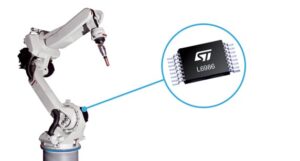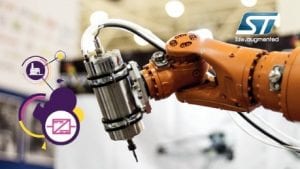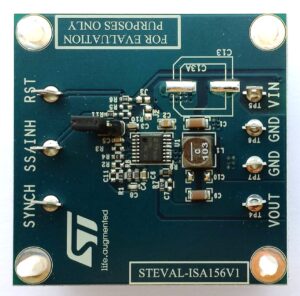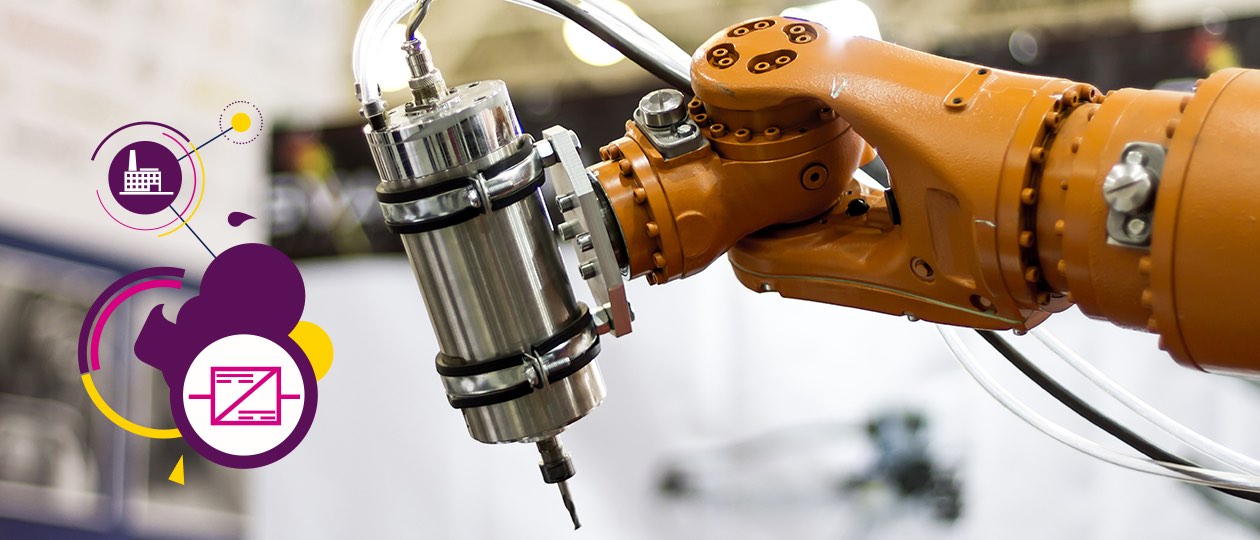The L6986, L6986F, and L6985F make-up ST’s new family of synchronous step-down switching converters (also known as buck regulators) for industrial applications with a high input voltage of 24 V. Faced with a myriad of constraints, technical specifications, and design considerations, choosing the right DC-DC converter can be an overwhelming process. Furthermore, when a failure forces a complete redesign of a power supply because a poorly chosen component leads to overwhelming heat dissipation, one quickly realizes that the margin for error is too small to make this a trivial matter.
The new DC-DC regulators first impress because they tolerate a broad range of input voltages, from 4 V to 38 V, to ensure that they are still useful in spite of an unstable power supply. This is crucial to guarantee that the buck regulators work in all sorts of applications, from smart factories that run multiple automated processes to buildings that suffer from an unreliable power grid. The components are also able to output a range of voltages from 0.85 V to the VIN (Voltage In), which means it’s possible to use them to power many different components. Ultimately, their impressive technical specifications are the fruits of their modern architecture.
L6986, L6986F, and L6985F: What Makes Them Modern?

It’s impossible to exhaustively list all of the components’ features in a single blog post. Yet, if we were to focus on major characteristics, it’s noteworthy that the L6986, L6986F, and L6985F each offer a DC output current of 2 A, 1.5 A, and 0.5 A respectively, thus ensuring that engineers can really pick the component that’s best suited for their design. After all, the whole point of a buck regulator is to scale the input voltage down and target a specific output current, while dissipating a lot less heat and offering a much better efficiency than alternative solutions, such as Low-Dropout Regulators (LDO). Hence, today’s designers can better find the component that best fits their precise needs thanks to the granularity of the ST catalog.
Nonetheless, step-down converters have the tendency to take a fair bit of space, which is why ST uses a monolithic structure, meaning that the high-side power MOSFET switch is located on the same die to offer a more compact design than a solution requiring an external power switch. Furthermore, the three devices are all support synchronous rectification, which means that they also house a low-side MOSFET. As a result, unlike asynchronous converters, there’s no need for an external power diode that dramatically augments design complexities, decreases efficiency, increases costs, and takes more space. The L6986, L6986F, and L6985F also have the additional benefits of being part of the ST ecosystem, which means they stand out from the competition because of their flexibility, and practicality.
What Makes Them Flexible?
 ST’s experience also shines through two significant features, the first one being an incredibly broad frequency range that spans from 0.25 MHz to 2 MHz. A frequency that low offers outstanding efficiency, but it requires the installation of a larger coil. Inversely, 2 MHz only demands a small coil, but negatively affects the efficiency. In many traditional applications, engineers will find the best compromise for their design. Something like 0.5 MHz ensures that inductors and capacitors aren’t too expensive, coils aren’t too big, and the efficiency is still excellent. However, frequency as high as 2 MHz is crucial for certain edge cases like telecommunication operations, because a lower frequency would run into interferences with AM bands (0.535 MHz to 1.605 MHz). Hence, the wide frequency range offers excellent design flexibility.
ST’s experience also shines through two significant features, the first one being an incredibly broad frequency range that spans from 0.25 MHz to 2 MHz. A frequency that low offers outstanding efficiency, but it requires the installation of a larger coil. Inversely, 2 MHz only demands a small coil, but negatively affects the efficiency. In many traditional applications, engineers will find the best compromise for their design. Something like 0.5 MHz ensures that inductors and capacitors aren’t too expensive, coils aren’t too big, and the efficiency is still excellent. However, frequency as high as 2 MHz is crucial for certain edge cases like telecommunication operations, because a lower frequency would run into interferences with AM bands (0.535 MHz to 1.605 MHz). Hence, the wide frequency range offers excellent design flexibility.
The new converters also have a quiescent current (IQ) that’s so low, it’s mind-blowing. Indeed, whereas the previous generation had an IQ of roughly 1 mA to 2 mA, the L6986, L6986F, and L6985F have a quiescent current of only 30 µA in light load. In a nutshell, this refers to the current consumption of the DC-DC converter while it is on, but running a very light load, or no load at all. The new components achieve new milestones thanks to a quiescent current consumption that offers new levels of efficiency.
What It Means for IoT?
The new quiescent current opens the door to new IoT applications. For instance, more and more factories run networks of sensors designed to gather more data about various operations. However, in some cases, these sensors spend the majority of their time sleeping, waiting for an event to trigger their startup sequence. As a result, the DC-DC converters need to be on, because the components will draw power when they wake up, but their load is extremely light, or nonexistent. In this situation, a high quiescent current means the device wastes a tremendous amount of energy. With a quiescent current of only 30 µA, it becomes feasible to conceive such IoT systems because the losses become genuinely negligible.
To reach such levels of performance, ST completely revised the internal structure of these three DC-DC regulators to aggressively use as little power as possible. They also apply significantly improved algorithms that handle these light loads better by adjusting the wait times and lowering the switching frequencies on the fly to reduce the current consumption and increase efficiency as much as possible. However, given the flexibility of the L6986, L6986F, and L6985F, ST gives engineers a choice between the ability to rely on a fixed frequency to prioritize a certain behavior for a particular application (low-noise mode) or benefit from the new algorithms that ensure a low quiescent current (low-consumption mode).
What Makes a DC-DC Converter Practical?

The L6986, L6986F, and L6985F also distinguish themselves from the competition by using an HTSSOP16 packaging that’s a little thinner than the one used by the previous generation of components, while offering a similar thermal dissipation, thanks to the exposed pad underneath the device. Furthermore, the three modules are pin-to-pin compatible, which means that engineers can use the same design layout for different applications with only minor changes needed to fit one of the other three regulators. On top of it, the components are so reliable that ST offers alternative versions for the automotive industry. They are internally identical, but the parts go through a different certification process to comply with that industry’s standards.
Another advantage of the ST ecosystem is the ability to use graphical interfaces to quickly choose the step-down converter that’s right for a particular design. As we’ve already talked about in the Life.Augmented Blog, eDesignSuite gives engineers an interactive simulation of their board and can even recommend the DC-DC converter that will best fit their requirements. Designers can also get their hands on the STEVAL-ISA156V1, the STEVAL-ISA190V1, and the STEVAL-ISA187V1, evaluation boards for the L6986, L6986F, and L6985F, respectively, which will jump-start developments and offer a very affordable entry point to the ST ecosystem. Hence, choosing ST means benefitting from smart components, great boards, and intuitive tools, rather than having to mind-numbingly go through technical specifications and second guess essential choices that could lead to losing time and increasing development costs because of a miscalculation.
